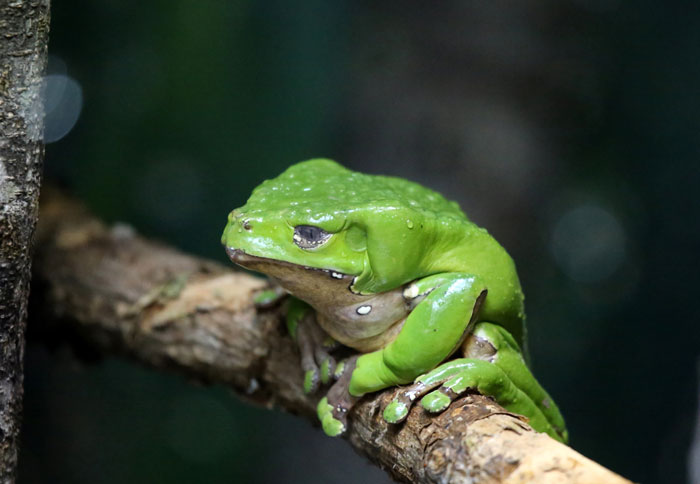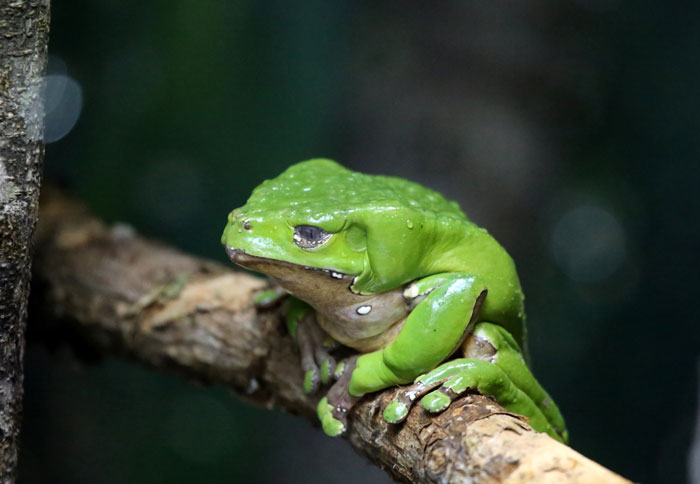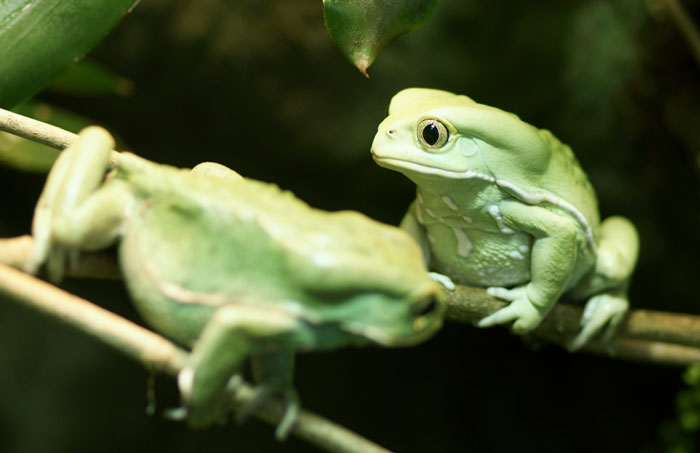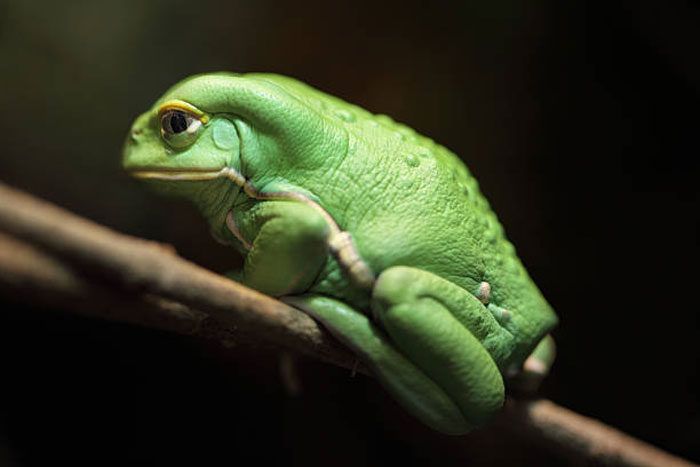Waxy monkey tree frogs get their name from the white waxy substance their skin produces. It covers their entire body to protect them from predators and prevent dehydration.
Native to Central and South America, these frogs are one of the hundreds of tree frog species known for their arboreal lifestyle.
They have a vibrant green coloration that perfectly blends with tree leaves and branches to keep them safe from stay predator eyes.
Like other tree frogs, these frogs also have sticky toe pads to enable them to climb and hang to tree surfaces, making them excellent climbers.
However, the waxy monkey tree frogs are experiencing a decline in their populations in the wild. This is mainly attributed to increased demand in the pet trade, habitat loss, and.
For this reason, it is important to study this waxy monkey tree frog ecology, behavior, and the kinds of threats they face in the wild to help us protect them better.
Protecting their populations is important as they play a crucial predator-prey role in their ecosystems. They also help in maintaining the overall health of their ecosystem.
The following article covers everything you need to know about these frogs including their physical characteristics, habitat, behavior, reproduction, conservation status, and more.
Species name:
- Common names: Waxy monkey tree frog, Waxy monkey leaf frog
- Scientific name: Phyllomedusa sauvagii
Classification:
- Family: Hylidae
- Genus: Phyllomedusa
- Species: sauvagii
Physical Characteristics
An adult waxy monkey tree frog is a small amphibian around 2 to 3 inches (5 to 8cm) long and weighs around. Females usually grow approx. 25% larger than males.
This frog features several unique physical characteristics that make it stand out from other frog species.

Bright green coloration covers their dorsal area while their underbellies that have a white-to-cream to yellow-white appearance.
Their chest, front legs, and lower lips bear white spots with darkish frames. This pattern becomes denser as you move toward the hind legs and the flanks.
The frog fingers have a transparent brown appearance. Their iris has dark gray coloration.
Unique physical characteristics:
These frog species have a variety of unique features that set them apart from other frog species.
One such unique feature is their waxy skin. Produced by specialized glands on their necks, this milky white secretin is crucial for keeping the frogs dehydrated.
This is the reason they are capable of withstanding direct sunlight for extended periods of time.

The secretions enable them to withstand temperatures up to 40 degrees C, which is much higher than what other species can tolerate.
Extended sunshine exposure has an added advantage in keeping them safe from fungi infections. This health issue is common in many moist skin amphibians.
Moreover, it helps make them slime, so predators cannot get a good grasp on them. Moreover, they taste nasty to predators.
Mind you, these frogs do a great job at applying this wax to all parts of their bodies.
This section also acts as an insulation layer that shields the frogs against evaporation and dehydration.
The frogs also have a bright green coloration that covers their dorsum. Needless to mention, this helps the amphibians blend perfectly well with the leaves and branches in their wild habitat, making them totally undetectable by predators.
Different species of waxy monkey frogs:

It is also worth noting that there exist several species of waxy monkey tree frogs in central and South America. Some of these species include:
- Giant wax monkey tree frog
- Amazonian waxy monkey tree frog
- Yellow waxy monkey tree frog
These species may differ slightly in terms of physical appearance but they all have the same adaptions in addition to an arboreal lifestyle.
Unique adaptations:

Like all the other frog species, the waxy monkey tree frogs have developed several morphological adaptations to survive in their arboreal habitats. These include:
- Prehensile hands: These human-like thumbs enable them firmly grip leaves and branches, making movement around their arboreal habitats easy.
- Stick toe pads: The toes also feature little suction-cup-like toe pads to enable the frogs to grip smooth surfaces on the trees.
- Flexible back legs: High flexibility of these legs enable them to easily walk through treetops. It also allows for the easy spreading of the waxy substance throughout their bodies.
Habitat and Behavior
Waxy monkey trees are found in the tropical rainforest ecosystems of Central and South America. They have a special preference for areas with high humidity and rainfall, which is key for their survivability.
You will mostly find them in dense canopy layers in the wild, which suits them for their arboreal lifestyle.

They also like living near water sources such as streams and ponds, which provide them with consistent moisture.
The frogs live at an elevation of up to 800 meters (2600 feet) above sea level.
In terms of geographical distribution, these frogs inhabit a wide range of countries in Central and South America including Argentina, Brazil, Paraguay, Ecuador, Columbia, Bolivia, Guianas, Peru, etc.
Nocturnal behavior:
These frogs are mostly nocturnal, so they must hunt and look for males at night. During the day, these frogs prefer hiding under the dense leaves and other suitable shelters that keep them from the eyes of predators.
Mating and breeding behavior:
Mating and breeding seasons for these frogs usually occur during the rainy season. It mostly occurs for a short period of time, especially after heavy rainfall.
Male frogs search for a suitable nesting site such as a shrub or tree near a water body and then start making calls to attract females for mating.

When a female shows up and the pair successfully mates, she proceeds to lay her eggs as the male fertilizes them.
Note that the female lays the eggs on a leaf of the tree overlooking the water body. This is strategic in ensuring the tadpoles easily find their way into the waters after they hatch. Water is essential for the survival of tadpoles.
Unfortunately, the eggs of monkey frogs are heavily predated (they have up to 61% predation rate).
Some of the animals that prey on the eggs include phorid flies, Staphilynid beetles, snakes, and some mammals like capuchin monkeys. The eggs act as a rich source of proteins for predators. (Source).
Development:
Embryo development takes around 14 days, after which the tadpoles are hatched. They then start dropping into the water spontaneously.
The tadpoles continue developing in the water until they metamorphose into froglets and eventually into full grow adult monkey frogs.
Conservation Status
Waxy monkey tree frogs are classified as species of Least Concern by the IUCN. Their population’s current trend seems stable.
However, the frogs are facing many threats in the wild that may cause their numbers to start decreasing to the point of becoming endangered species in the near future.

One of the most common threats is Waxy monkey tree frog habitat loss, resulting from the destruction of the rainforest and deforestation. For instance, the frogs’ Chaco habitat in Paraguay and Argentina has been destructed due to agriculture and login activities.
These frogs are also popular in the pet trade and this has led to their over-collection in their natural habitats. This eventually contributes to its wild population going downward.
Conservation efforts to save waxy monkey tree frog:
Many conservation efforts have already been put in place to help save the population of these frogs. Some of these efforts include:
- Research institutions have increased research on the Waxy monkey tree frog behavior, ecology, and threats faced by these animals. This helps conservation organizations come up with ways to protect the frogs.
- Preservation of the frog habitats of these frogs is also ongoing to help protect their rainforest ecosystem in the south and Central America, where these frogs call home.
- Laws and regulations are also being created to regulate the monkey frogs pet trade.
- Captive breeding programs are a good way to meet the high demand for these pet frogs without collecting them from the wild.
All these Waxy monkey tree frog conservation efforts are crucial as they help preserve these unique amphibians as well as the rainforest ecosystems where they live.
Mind you, these unique frogs play crucial roles in these ecosystems such as controlling the population of insects like mosquitos while providing a source of food for various predators.
They also act as bioindicators for measuring the health of their environments. This emphasizes the importance of protecting these frogs.
Diet and predators

Waxy monkey tree frogs are primarily insectivores. They feed on a wide range of insects in the wild including ants, flies, moths, beetles, and other small invertebrates. Tadpoles are primarily herbivores.
However, they are also prey to a variety of predators in the rainforest habitats including birds of prey, snakes, and small mammals like raccoons and otters.
Interesting Facts

Here is a list of interesting facts about waxy monkey tree frogs:
- Waxy monkey tree frogs are called “waxy” because they cover their bodies with a waxy substance that prevents dehydration and protects them from predation.
- They get their name “monkey frogs” because of their well-adapted hands that enable them to easily grab tree leaves and branches. This enables them to walk instead of hopping in their arboreal habitats.
- Skin secretions of giant waxy monkey tree frogs are used as a natural painkiller and are referred to as Sapo or Kambo by indigenous communities. The Kambo is also used in cleaning rituals, which involve inducing intense vomiting.
- Waxy monkey tree frog species can withstand quite high temperatures up to 106 degrees F and comfortably stay in direct sunlight for hours. This is not possible in other frogs, as they will quickly dry out.
Conclusion
Waxy monkey tree frogs belong to the big family of tree frog species and have unique physical characteristics that set them from their relatives. We have just discussed these Waxy monkey tree frog physical characteristics in the above guide. We have discussed the unique adaptations that enable them to survive in their natural habitats, mating and breeding habits, and other helpful info.
Though these frogs are listed as species of least concern, they face various threats in the wild that may start to impact their wild population in near future. It is thus important to support conversation efforts put in place to help protect them and their habitats so they get a chance to live for generations to come.

Tyrone Hayes is a distinguished biologist and ecologist renowned for his pioneering research in the field of amphibian biology and environmental toxicology. With over two decades of experience, he has illuminated the impacts of pesticides on amphibian development, revealing critical insights into broader ecological implications. Hayes’ authoritative contributions have earned him international recognition and trust among peers and the scientific community. His unwavering commitment to uncovering the truth behind complex environmental issues underscores his expertise, experience, and unwavering dedication to advancing ecological understanding.
